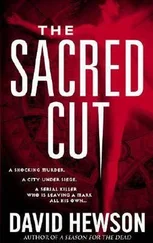“You’re not local, are you? Most of the little islands are uninhabited. You couldn’t just hide someone there. You’d need a roof over your head. Besides, those little ones get looked after by the conservationists and the archaeological people. They’d be screaming the roof down if they found so much as an empty Coke can. I don’t think . . .”
“I know, I know.”
It was a stupid quest and Correr saw he didn’t have to point that out.
“So where would you hide someone?” the cop asked.
Correr laughed. It was obvious. “If I was a farmer on Sant’ Erasmo? In my back garden. Or somewhere nearby. That place is bigger than Venice. No one goes there except the locals. I don’t think they even have police.”
“They don’t.”
“Then there you go. Search the island. You can’t do it from the air. You’re going to need a lot of men too because the matti wouldn’t piss on you if flames were coming out of your ears.”
“Take me back there,” the man ordered.
“Sure . . .” Correr wheeled the big tin bird round and set the nose on the low silhouette of Sant’ Erasmo, black against the bright horizon. “Anywhere in particular?”
“Southern tip. Away from the vaporetto stop. Away from everyone. You have a maritime map of the lagoon by any chance?”
“Four. They’re known as charts, by the way.”
Correr reached into the glove compartment, scrabbled behind several half-spent packets of cigarettes, and found the set he wanted. The cop stared at them, surprised.
“This is a floatplane,” Correr explained. “Besides, I sail too. And I happen to like charts.”
“They show buildings? Individual houses?”
“You’d be amazed what you can find on charts. Of course, on Sant’ Erasmo you’d need to double-check everything.”
“Why?”
People from terra firma. They just didn’t get it.
“Because the matti do what the hell they like. Throw up a little baracca for granmama, just so’s she doesn’t have to annoy the hell out of you living in the same house. No one’s going to tell the authorities. It happens all the time. And why not? Out here, who cares?”
It took less than three minutes. Then they went into another forty-degree roll, Correr feeding some extra throttle in and kicking the rudder hard so enough g-force came in to squeeze them into their seats a little. His passenger hadn’t looked a good flyer when he came on board. Now Correr was changing his opinion. Just to check, he pumped in some more throttle and took the aircraft over to sixty degrees, nailing it into as steep a turn as he dared at that kind of altitude, one that forced both of them hard into their seats and pitched the nose of the Cessna round in a vicious circle, as if it were tethered to a wire. At that angle even he could see down below: fields and shacks and mess. Just the usual.
But, a third of the way through the turn, he spotted something on his passenger’s face. Correr went through three sixty, levelled off, same height, same place on the horizon he’d entered the turn, gave himself ten out of ten for flying, then pointed the Cessna’s nose out to sea. The cop stopped looking out the window and stared at him instead.
“There’s a little shack down there. It’s not on the map. I didn’t notice it before.”
“Like I said. It’s called a chart. There’s a reason you didn’t see it. You weren’t looking. That’s one thing you learn in a little plane. How to look.”
The man nodded. “When you made all that noise a woman came out and started staring up at us.”
“Was she pretty?”
“Couldn’t see.”
“Maybe we should go back and take another look. A little lower this time.” He eyed the cop, expectant. “You are going to get me out of all the shit if it hits the fan, right?”
“Guaranteed,” he said promptly, then strained backwards, looking towards the green tip of Sant’ Erasmo.
Correr did the same. There was a tiny beach not far from the end. He had an idea what was coming next.
“I want you to put me down there,” the cop said, glancing at his watch. “Now.”
“And then?”
“Then you go back to the airfield. I won’t need you anymore.”
He sounded uncertain about that last point. Correr wondered whether to object.
“I can carry four people in this thing, you know. It’s no problem. Really.”
The cop smiled, for the first time since they’d met, and, for no particular reason, Andrea Correr decided he liked this little man, in spite of the badge.
“Thanks, but no thanks. You’ve done enough. Just get us down, please.”
Correr glanced back at the island. Someone was burning charcoal or something. The smoke was drawing straight off towards the open Adriatic, not too quickly, all in a straight line.
Land into a good, reliable wind. Taxi round and take off in the same direction.
His mouth was dry, in the way it used to be when he was first learning to fly on the Lido all those years ago, in a tiny fixed-gear Cessna 150 that was a baby brother to this more complex bigger beast. He could still remember those lessons in Florida. They made it sound so easy after a while. In a way, making it easy was part of the secret.
He laughed to himself, took the half-smoked cigarette from his lips and flicked it out the window. Then he worked the wirepull to withdraw the wheels back into the floats. The plane had been through its annual certificate of airworthiness only two months before. Everything—flaps, ailerons, throttle, gear—worked smoothly.
He pulled the 180 round into the wind, facing the island, and set up for a long, flat descent, nose up, holding the bulky Edos off the water, at just the right angle, until he’d killed enough speed to make it safe to put them down on the waves. Hit it badly and you’d soon discover how hard an object water really is. Someone had written off a Cub while he was there, and that was on a lake that looked like perfect glass, not the dappled, random rippled mesh of wavelets that stood between them and the island.
The man in the next seat was bracing himself nervously. Correr knew why. He’d done the same the first time he’d landed on water. You never appreciated how much the surface would brake the aircraft. Water wasn’t like grass or asphalt. With a good landing the plane came in at around 60 knots, placed its feet onto the surface, then got dragged to a halt in less than a hundred metres.
Which meant they looked perilously close to hard, stony land as they approached, too close, he guessed, and mentally began the countdown for a go-round if things got too close to the margin.
Some story for the flying club, Correr thought, then cut the power altogether, held up the nose, let the speed die, felt the yoke go weak and shaky in his hands as the wings began to lose their grip on the air . . . and, with a loud bang of wave against metal, landed the aircraft plum in front of the beach, coming to a rest no more than ten metres from the sand.
He undid his belt, opened the door and leaned out to look down over the side. He could see the bottom beneath the sea already, rocks and pebbles and tiny fish.
“I can’t go much further,” he said. “Get down and walk out to the front of the float. You can take me in until you see the sand getting so shallow I might hit it. These things don’t do reverse.”
The cop was taking out his wallet, removing a wad of notes.
“Thanks,” he said, extending the money.
“No,” Correr replied with a smile, then grabbing the cash. “Thank you.”
The cop had to wade through about a metre’s depth of water to get on shore. Then Correr turned his plane around, taxied out into the open lagoon, turned once more and performed a takeoff so perfect he wished the surly old instructor at the school in Florida could have seen him.
Читать дальше












